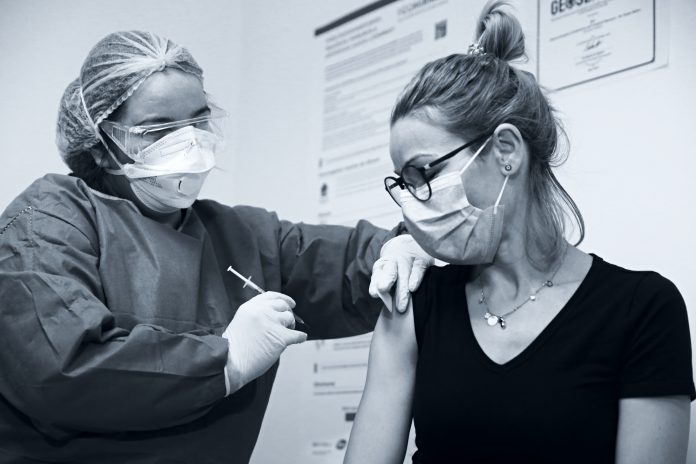An anonymous Doctor explains how the NHS could tackle the significant logistical challenges of giving COVID vaccines
As a doctor, I can confidently say that vaccinating patients is quite a simple exercise. On paper, volunteering to administer the COVID-19 vaccine into people’s arm should be a very easy, straightforward task for healthcare professionals like me.
However, despite the urgency of the current situation, the reality and size of the logistical challenges of both setting up the vaccination centres and sourcing qualified healthcare professionals to staff those sites is quite the opposite.
Time is of the essence right now
The faster we can vaccinate the UK’s population, the more lives will be protected, hence why this massive rollout requires healthcare organisations to operate far quicker than they have in the past.
Primary care especially has been asked to move quickly, once again, this time with financial support including an NHSI/E £150 million funding stream with official guidance resources. Clinicians and other healthcare professionals truly value clever solutions which can help them do their work faster, enabling them to focus on patient care. Health tech, as well as better structured NHS IT systems and software, have an important role to play in solving some of the most critical logistical challenges.
In such a rapidly evolving context, misinformation, confusion and uncertainty are creating inefficiencies at system level, slowing down the entire process. The current process to check healthcare professionals’ credentials and enrol them into vaccination hubs has shown some limitations. Many healthcare professionals have come out of retirement, given up caring responsibilities or paid work to join the nation’s biggest vaccination program without being able to, despite their best attempts.
I have personally been through this experience; jumping through the hoops of bureaucracy and seeing very little progress.
“jumping through the hoops of bureaucracy and seeing very little progress.”
Albeit these steps are wholly appropriate, the way in which the system is organised could be improved to avoid the disjointed, multiple stage confusion currently in place. This made me wonder, how many well-meaning healthcare professionals are being lost during a national effort because of an inefficient process? Certainly, now isn’t the time to alienate our NHS community and so how can technology create synergy between the system working and capitalising on healthcare professionals enthusiasm to support such a gargantuan effort?
Pragmatic tech solutions for Primary Care Networks (PCN):
1. Total Triage
When the COVID-19 pandemic hit, NHS England encouraged general practice to move to a ‘total triage’ model, where every patient is triaged via a phone call or online form before making an appointment.
This form of triage has a number of benefits as patients are seen based on their clinical needs rather than on a first come/first serve basis with the immediate results of decreasing footfall in GP practices. This, for example, helps reduce the logistical burden of the vaccine roll-out. Good examples of digital solutions enabling online triage, such as eConsult, are making a real difference as online rather than phone triage has shown to hugely improve both resilience and resulting reliability within the primary care community.
Online triage and remote consultations have been especially beneficial for those who are vulnerable, need extra care, and do not like using electronic devices. This is because the system frees up both the phones and clinician time. The online system is flexible enough to cope with a number of factors such as: self-isolating doctors, self-isolating patients and even temporary loss of practice premises.
2. Booking vaccination slots
Primary care practices have been asked to work out the total number of patients in their priority groups, factor in how many patients will need a home visit, consider how they can cover care homes, pool their capacity to deliver the vaccine across PCNs etc.
With the experience of flu jabs over the years to inform us on upcoming issues with the COVID vaccine, we know this specific vaccination infrastructure will be less effective for COVID. Between existing booking frictions and factoring in the second shot, managing booking, vaccination slots efficiently is paramount to the success of the vaccination program.
AccuRx is one example of how technology can have a real impact on solving key logistical challenges. Their communication software enables practices to contact and inform patients with personalised communications, allowing instant bookings and automated reminders for booking and appointments for both vaccine doses. Part of the success of AccuRx is how it enabled quick uptake of online consultations as many practices already had it in place.
3. Staffing the vaccination centre
A national fund of £120k (in addition to the £150m NHSI/E fund) per CCG has been announced to support GP recruitment during the vaccine roll-out. Despite the fact that online consultations, at some levels decreased the need for GP time for some practices, the size of this national effort to administer the vaccine calls for a need to source clinicians and healthcare professionals rapidly and efficiently.
Again, technology can help alleviate the pressure on Practice managers by enabling them to safely and rapidly recruit qualified healthcare professionals. Locum’s Nest, the platform connecting doctors to vacant work in the NHS, has helped staff vaccination hubs at, among others, North Middlesex University Hospital NHS Trust (which can be staffed by 5,000 clinicians across The Digital Collaborative Bank), and Cambridge & Peterborough Training Hub – enabling collaboration between primary and secondary care settings.
*The identity of the author has been confirmed by the editor.











